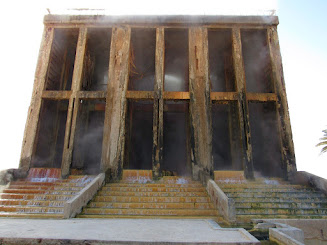It looks like an eerie, lifeless moonscape. And, even though they are called "lakes", they are not lakes at all. They are expanses of dried mud covered with a thick crust of white or gray salt. The glistening salt in the sun makes them look as though they hold water. Geologists believe these lands were part of the Meditarranean Sea that were formed by tectonic plates that collided. That's why there are mountains and flat lands next to each other.
Greek mythology refers to salt "lakes" as they describe a sea with monsters. In the 12th century, Arab travelers describe crossing these lands. They'd follow the same path in order to avoid being trapped by quicksand as a runaway camel did when he fell through "the lake" and died.
Arab engineers have built the road that passes through these lands, however, maintenance is constant because the road sinks. We passed a work crew here.
The Arabs called these "lakes" shats and the French transliterated them to chotts, which means broad canal or estuary. The "lake" that we saw was called Chott El Jerid, the largest in the Sahara Desert. The three chotts in this area are 2,000 square miles in size and nothing lives there and nothing can be built there. (One of the battles in the film, Star Wars, took place here.)
If it rains, the "lakes" turn to quicksand, so it is necessary to wait two to four weeks for the land to dry before walking on its surface. The water can accumulate to reach three to four feet. Nevertheless, if you dig in the dry mud about the length of your arm, you can reach water. So, if you walk on this mud, you could lose a shoe.
People visit here because it is a gem of Nature. In fact, when our guide was a teenager, he and his family would visit the "lakes". He said when there is water on the "lakes" it is a spectacular sight because the mountains reflect on the water and the salt twinkles. This phenomenon forms a mirage because hot air reflects light and creates an optical illusion.
In 2023, Tunisian fashion models did a shoot here where they were walking on the "lake". TexSpace Today recorded the event.
There are other minerals here besides salt. For example, the iron makes the soil rusty. Evaporated rain leaves the salt behind and leaves a film of salt on the surface.
Many
people take a "Sunday" drive to the salt lake. Some have a little fun
by pretending they are on the moon. They construct Star Wars characters
and plant flags on the desert mounds.




These men take advantage of the hot water to do a little thermal bathing.
Resources
Salt Lakes -- https://en.wikipedia.org/wiki/Tunisian_salt_lakes
water on Salt Lakes -- https://www.istockphoto.com/fr/photos/chott-el-jerid
models on Salt Lakes -- https://www.texspacetoday.com/tunis-fashion-week-2024/















